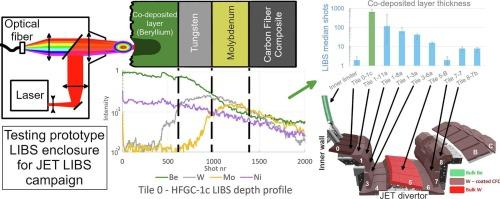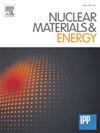Preparing LIBS for in-situ measurements in JET tokamak: system overview and co-deposited layer thicknesses
IF 2.7
2区 物理与天体物理
Q1 NUCLEAR SCIENCE & TECHNOLOGY
引用次数: 0
Abstract
Laser-induced breakdown spectroscopy (LIBS) is a method for elemental composition analysis that has been proposed for fusion reactor safety diagnostics. A significant milestone in this development was the LIBS campaign conducted in 2024 at the Joint European Torus (JET), using a prototype LIBS enclosure, deployed with the MASCOT tele-manipulation arm. The work presented here prepared for the JET campaign by testing the LIBS enclosure.
Experiments were conducted at VTT Technical Research Centre of Finland, analyzing JET wall samples from the 2011–2016 ILW1–3 fusion campaigns, primarily from the divertor. The focus was on the analysis of co-deposited layers on the plasma-facing components containing hydrogen isotopes and elements from bulk layers: Be, W, Mo, CFC, and Inconel. Measurements were performed under atmospheric pressure air with an argon flow.
Optimal experimental conditions for the use of an Echelle spectrometer in subsequent JET LIBS campaign were identified, and the depth profiles of the surface layers are presented. The LIBS depth profiles defined distinct material layers. Ablating through the co-deposited layers required 1–870 laser shots (∼0.1–90 µm) on samples from different locations, with typical variations of 10–40 % on the same sample and the largest variation spanning 15–480 shots (∼1.5–50 µm).
The LIBS, Secondary Ion Mass Spectrometry (SIMS), and optical profilometry results showed good qualitative agreement. The ablation rate was ∼30–50 nm/shot for the W layers, ∼100–140 nm/shot for bulk Be limiters, and intermediate for the co-deposited layers. The insights gained in this study supported the preparation of the JET LIBS campaign.

为JET托卡马克的原位测量准备LIBS:系统概述和共沉积层厚度
激光诱导击穿光谱(LIBS)是一种用于核聚变反应堆安全诊断的元素组成分析方法。这一发展的一个重要里程碑是2024年在欧洲联合环面(JET)进行的LIBS运动,使用了一个原型LIBS外壳,配备了MASCOT远程操纵臂。本文介绍的工作通过测试LIBS外壳为JET活动做了准备。实验在芬兰VTT技术研究中心进行,分析了2011-2016年ILW1-3聚变运动中的JET壁面样本,主要来自转向器。重点分析了共沉积层中含有氢同位素的面向等离子体组分和来自体层的元素:Be、W、Mo、CFC和Inconel。测量在常压下进行,空气中有氩气流动。确定了在后续JET - LIBS活动中使用梯队光谱仪的最佳实验条件,并给出了表层的深度分布。LIBS深度剖面定义了不同的材料层。通过共沉积层的烧蚀需要在不同位置的样品上进行1-870次激光照射(~ 0.1-90µm),在同一样品上的典型变化为10 - 40%,最大变化跨越15-480次(~ 1.5-50µm)。LIBS,次级离子质谱(SIMS)和光学谱分析结果显示了良好的定性一致性。W层的烧蚀速率为~ 30-50 nm/shot,大块Be限制器的烧蚀速率为~ 100-140 nm/shot,共沉积层的烧蚀速率为中间速率。在这项研究中获得的见解支持了JET LIBS活动的准备。
本文章由计算机程序翻译,如有差异,请以英文原文为准。
求助全文
约1分钟内获得全文
求助全文
来源期刊

Nuclear Materials and Energy
Materials Science-Materials Science (miscellaneous)
CiteScore
3.70
自引率
15.40%
发文量
175
审稿时长
20 weeks
期刊介绍:
The open-access journal Nuclear Materials and Energy is devoted to the growing field of research for material application in the production of nuclear energy. Nuclear Materials and Energy publishes original research articles of up to 6 pages in length.
 求助内容:
求助内容: 应助结果提醒方式:
应助结果提醒方式:


